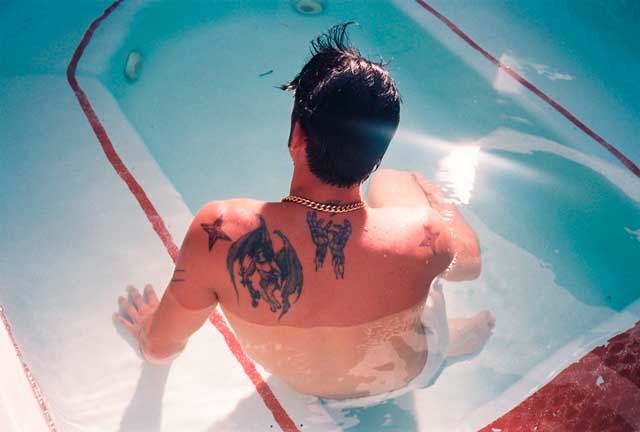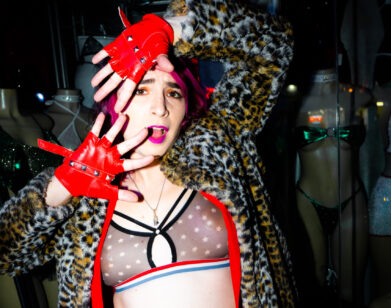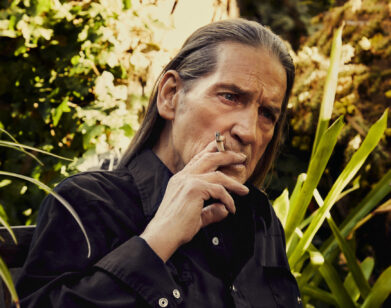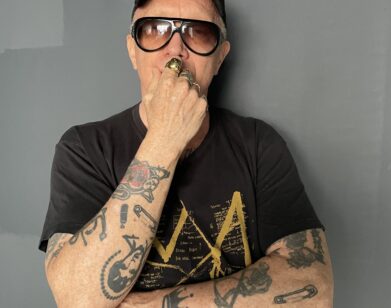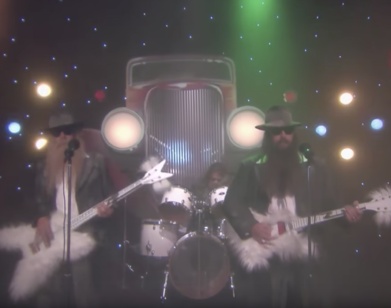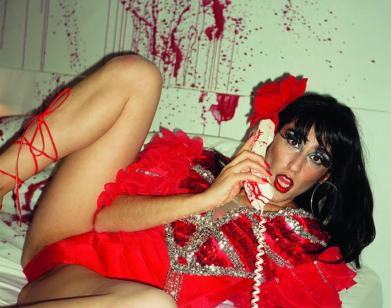Transgressive filmmaker Bruce LaBruce talks Faggotry with Slava Mogutin
Bruce LaBruce is gay but holds the political Left at arm’s length. He’s bored to tears of the PC police and more than willing to vex with his eye-poking, transgressive work. LaBruce trades in campy pornographic art films (Hustler White [1996] is a personal favorite), photography, musical theater and even statement jewelry. The 54-year-old has sifted through his provocative photo archive for a show called “Faggotry,” on view online only at the Tom of Finland store.
Despite his radical work—beginning first with a queer punk zine called J.D.s—LaBruce doesn’t aim to fit any progressive mold. He sees himself more as a radical Centrist, making films that Americans would probably dub “locker room” content or denounce as smut. A bigger budget film he has in the works, Saint-Narcisse, is about twincest, and a hardcore porn comprised of four short films he has made for gay porn site CockyBoys, It Is Not The Pornographer That Is Perverse…, is about to hit the queer festival circuit before streaming on the site in March. He’s still too risqué for woke liberals, feeling he can’t identify with them because it would require giving up the privilege of offending people.
It’s perhaps only in Russian photographer Slava Mogutin that he’s met his creative equal. Mogutin, 43, has similarly led the charge for queer culture, attempting to register the first same-sex marriage in Russia before being chased out of the country entirely. Gaining political asylum in New York, Mogutin met LaBruce in 1997 at New York’s Club Mother at a book signing. He then appeared in the filmmaker’s agitprop porno Skin Flick [1999] and has been photographing LGBTQ life in New York since. In the two intervening decades, they have remained friends and recently dialed each other up to dissect the word “faggot,” Fassbinder actors and the social aspects of using Grindr.
SLAVA MOGUTIN: “Faggotry” is such a punchy title. I remember the last time you were in New York, you accused me of overusing the words “fags” and “faggots” … And here you are.
BRUCE LABRUCE: It depends on the context. I mean, we could get into it.
MOGUTIN: Do you think the term is insensitive to members of your gay audience?
LABRUCE: I’m just so over so much politesse, so much tiptoeing around words, and the whole language police, especially on the Left. I’m really over it. I think in a way it’s important to keep these kinds of taboo words active just because people are already totally paranoid about what they can say or should say and the kind of language they should use. But sometimes it’s good to—almost like Tourettes—just bark something out. It’s like a release, like a liberation from oppression on the Left.
MOGUTIN: I can relate to the Tourettes part, certainly. I remember when you did a premiere of Gerontophilia [2013] at MoMA and there was a Q&A afterwards. And some gentleman member of the MoMa asked you something like: “Thousands of years of human civilization led us to this?”
LABRUCE: He was like, “Three thousand years of human civilization and progress and culture—and we’re reduced to this.” [both laugh] My film.
MOGUTIN: What was your response?
LABRUCE: It was a great question. I was a bit taken back, a bit stunned. It was one of those things, where, where do you begin? In my answer I had to explain so many things that are so intrinsic and second nature—the idea of camp, the idea of queer politics, the idea of pornographic representation in art—you know, all these things that I take for granted. The person who asked that question didn’t have a context for any of it. I was talking about Warhol films, the avant-garde and avant-garde aesthetics, alienation techniques, Brechtian distanciation. There are so many ways that you could approach that film in terms of its references and its meaning, so you’re kind of at a loss where to even begin.
MOGUTIN: What would be your short answer to someone who cannot see past nudity and only sees gore and porn in your work?
LABRUCE: Read a book.
MOGUTIN: What book in particular?
LABRUCE: Go to an art gallery. The Vatican has the largest collection of pornography in the world. The whole history of representation, the whole history of art is thoroughly imbued with pornographic imagery and the pornographic imagination and violence and gore. Look at Guernica. I don’t know. It’s hard to even know where to begin again.
The art world, especially lately, holds this conservative attitude toward sexual imagery, especially if you work too closely with pornographic conventions, which is one of my trademarks. As you know, for many of my films I’ve made a hardcore and a softcore version and the hardcore version is full-on pornography. But it’s in a context that is much more elaborate and conceptual. There’s a new moralism because the art world is based solely on marketing images that are very mainstream and that look good hanging in your dining room, I guess.
MOGUTIN: Right. Let’s talk about guns in your work. It’s also a tricky subject considering the current political context. The NRA having such a powerful lobby. How would you explain the fact that you’re so attracted to guns or seem to be using them quite often?
LABRUCE: It’s interesting in a sexual context. It’s such hypocrisy. When someone like me, an underground artist, [shows guns] it’s considered going too far or only using that imagery for shock value. But if you look at any major Hollywood motion picture, it’s full of pornographic violence. Almost every major TV show on whatever channel, HBO or Netflix, the series almost always starts out with the mutilated body of a woman as the starting point of the narrative. It’s mainstream, it’s totally mainstream.
MOGUTIN: What I like about your work is the fact that you use porn in this very ironic, almost satirical way where it’s stripped of its original purpose to arouse and entertain. I wonder, considering how long you’ve been working in porn and using porn as a reference point, are you personally a big consumer of porn? And if so, what kind of porn?
LABRUCE: It’s so weird to talk about porn to a new generation of kids because I was talking to somebody the other day and they said that the average kid is exposed to porn at 9 or 11 years old. Like really hardcore porn—they have access to it. Kids totally get around adult filters, so it’s so different. It’s light years away from my experience where my older brother would have books hidden like Penthouse magazine that I would sneak a look at, or Henry Miller books and Burroughs as well.
MOGUTIN: I remember when I was growing up in Russia, it was basically the source for when you couldn’t find official books of banned literature. It was always readily available in samizdat and that’s how I read Henry Miller and Bukowski and Nabokov’s Lolita.
LABRUCE: That was more our pornography in a way.
MOGUTIN: You told me you just joined Grindr. Is it true?
LABRUCE: I just joined Grindr and Scruff for the very first time.
MOGUTIN: There you go. So you’re fresh meat on the block.
LABRUCE: Yeah—it’s weird because they’re different than I expected. I thought it would be more old school, like sex hookup websites before I was married that were for sex hookups. But this is definitely more like ordering in pizza, which is cool, you know?
MOGUTIN: There’s no romance in it.
LABRUCE: Well, sometimes you’re in the mood for a cum dump and sometimes you’re in the mood for romance. It’s much more chatty than I thought it would be like; you can get to know a person and it can be more of a social tool. I didn’t really think of it so much that way. Lately, at this age, I’m much more of a sex object than I have been for quite some time. I was thinking the other day, instead of trying to count sheep to get to sleep, I was trying to count how many people I’ve fucked in your apartment.
MOGUTIN: [laughs] I’m sure it would be a long list. Going back to your pictures, there’s one great shot of [German actor] Volker Spengler from In a Year of 13 Moons [1978], which is one of my favorite films. How did you guys meet?
LABRUCE: I met Volker Spengler through Susanne Sachße, an actress I work with quite a lot. She’s in The Raspberry Reich [2004] and The Misandrists [2017] and I’ve done a lot of theater with her. She had worked with him on stage before so we went out with him one night and ended up back at his apartment doing blow. He hangs out at Tabasco, the hustler bar in Schöneberg in Berlin, so I would run into him there occasionally. He always scared the shit out of me; he’s a very imposing mountain of a man. But I did ask him to be in The Raspberry Reich, and he declined. Even insane Fassbinder stars are reluctant to appear in my movies.
MOGUTIN: That’s quite a compliment.
LABRUCE: [laughs]
MOGUTIN: There’s another great shot [in “Faggotry”] of Udo Kier from when we were doing the performance together.
LABRUCE: Yeah, what was that called … Was that Visions of Excess? It was in Birmingham, England.
MOGUTIN: And Ron Athey and Vaginal Davis curated the show. I remember we shared a room, there were bloody props and me and my ex, Raoul, were trying to muster our performance for The Trials of Gilles de Rais based on Georges Bataille.
LABRUCE: That was a very memorable weekend.
MOGUTIN: Yes, it sure was. Bruce, let’s talk about your latest film, The Misandrists, which I thought was very funny, kind of like a new take on Beyond the Valley of the Dolls [1970] and Women in Revolt [1971].
LABRUCE: Yes, I love Women in Revolt.
MOGUTIN: We watched it together for the first time. It was in Prague.
LABRUCE: We were high and we laughed and laughed and laughed.
MOGUTIN: Absinthe and pot, yes.
LABRUCE: Was that before or after we picked up the two hustlers at Pinocchio?
MOGUTIN: Good question—one of them stole your socks, I remember. So The Misandrists … What’s going on with the release? You told me there were some difficulties with releasing it in the U.S. because it’s a lesbian saga by a male director.
LABRUCE: The Misandrists premiered at the Berlinale last February, so it’s almost been a year. It’s been shown around the world—everywhere except America. There was even a screening in Moscow, The Istanbul International Film Festival and the Kolkata International Film Festival. But the main LGBTQ film festivals in America wouldn’t show it. Toronto, as well, my home town. There’s this weird kind of political correctness—The Misandrists really digs into gender politics and feminist politics in a way that I don’t think people are used to.
For me, it’s always been essential to my work to critique the Left as much as the Right. I feel alienated from the Left now in that I don’t identify with it anymore. I consider myself a radical Centrist. But it’s this reluctance to really be critical and dig into the issues behind what people usually talk about; like in terms of feminism, no one ever talks about class issues or the problems of second-wave feminism, the anti-sex, anti-porn feminists right up to and including [radical feminist and writer] Andrea Dworkin, who considered any penetrative sex rape. She considered the missionary position rape. So there’s a lot to be said about those issues and the film does it in a camp and comedic way—and I guess some people just don’t think it’s funny. But it will be released in the States in the spring.
MOGUTIN: Maybe we should talk a little bit about your next project.
LABRUCE: It’s gonna be coming out in the next couple months. It’s called It is Not the Pornographer That is Perverse and [gay porn site] Cocky Boys will release the hardcore version in March. Then I have this long term project I’m working on that will be a big budget feature, the working title was Twincest but now it’s called Saint-Narcisse. But it is about twincest—identical twin boys who were separated at birth and one of them was raised in normal society in the city and the other was raised by monks and they meet again—not even knowing that they had a twin—in the early ’70s and … Let’s just say that their attraction is more than fraternal.
“BRUCE LABRUCE: FAGGOTRY” IS AVAILABLE TO VIEW ON TOMOFFINLANDSTORE.COM

